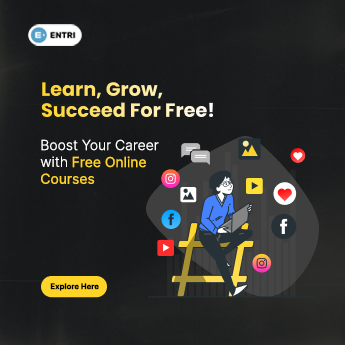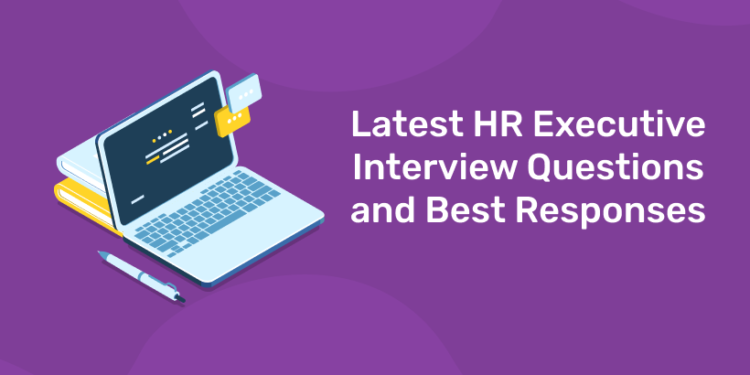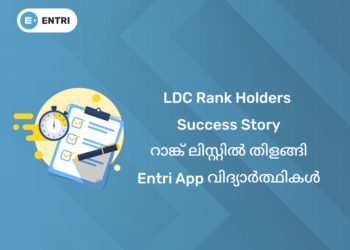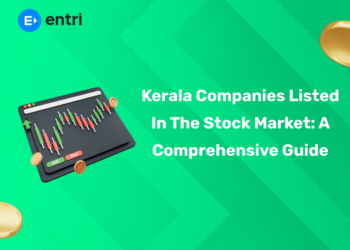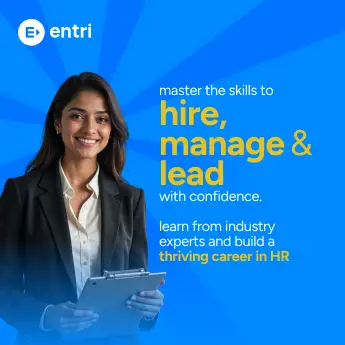Table of Contents
Introduction
HR Executive is the highest order designation in the company. As a result, the demand for competent HR professionals is higher than ever, as people-based management is recognized as an essential catalyst for overall business success. Preparing for an HR Executive interview can be difficult, especially in the current competitive job market. However, while preparing for the HR Executive Interview Questions/Answers from here, it must be easy for you.
By knowing the common questions and answering them you can show yourself as a strong candidate to handle HR challenges. Also if you are looking to upskill and knowledge in Human Resources, consider enrolling in the HR Management Course in Kerala offered by Entri which will give you a solid foundation and practical knowledge in the field.
HR Executive Interview Questions
Here are some of the latest HR Executive interview questions that you may face in your interview:
1. What experience you have in recruitment and selection?
Answer: “In my previous role I managed the full recruitment process for various roles from entry level to management. I used different sourcing methods, job boards, social media and employee referrals to source diverse candidates. I did initial screenings, behavioural interviews and worked with department managers to create tailored interview questions. I looked at technical skills and cultural fit. I also implemented an applicant tracking system (ATS) to streamline the process and improve candidate experience which resulted in 20% reduction in time to hire.”
2. How you handle employee performance issues?
Answer: “I address performance issues early. I monitor employee performance through regular check ins and feedback sessions. When issues arise I have a private conversation with the employee to get their perspective. We identify specific areas for improvement and create measurable goals in a performance improvement plan. I provide ongoing support and resources, training or mentoring to help them succeed. We fix the issue and reinforce a culture of continuous improvement.”
3. What do you do for employee engagement?
Answer: “To increase engagement I focus on recognition and development. I run programs that celebrate achievements, ‘Employee of the Month’ awards and team building activities to boost morale. I also advocate for professional development opportunities, workshops and training sessions to help employees grow in their career. Regular employee surveys give us feedback and we address issues promptly. Over time this has resulted in huge increase in employee satisfaction and retention rates.”
4. How do you ensure compliance with labour laws and regulations?
Answer: “Compliance is number one in HR for me. I am constantly educating myself and doing professional development to be aware of local, state and federal labour laws. I do periodic audits of our HR policies and procedures for compliance. I also conduct training sessions for employees and management on compliance issues and workplace safety and anti-discrimination laws. Creating a culture of compliance will enable us to minimize risk and create a safe and fair workplace for all employees.”
5. Tell me about a tough HR situation you faced and how you fixed it.
Answer: “The biggest challenge I faced was high turnover in a key department. To get to the bottom of the issue I did exit interviews and found out it was management practices and lack of growth opportunities. I worked with department leaders to create a management training program on communication and leadership skills. We also created clear career paths for employees with regular performance reviews and development plans. As a result we saw 30% reduction in turnover within 6 months and employee morale improved greatly.”
6. How do you handle conflicts between employees?
Answer: When conflicts arise I address them straight away to prevent them escalating. I meet with each party individually to get their perspective and gather information. Then I facilitate a mediation session where both employees can air their concerns in a safe space. I guide the conversation to find common ground and mutually beneficial solutions. My aim is to create a collaborative environment and ensure the solution aligns with our company values and policies. This resolves the conflict and strengthens relationships between employees.
7. What role does HR play in organisational culture?
Answer: HR builds, develops and maintains organisational culture. We define the driving principles and behaviours in the fields of the company mission. I work closely with the leadership team to cultivate an environment of transparency, inclusivity and creativity. And determining what we need to do for our policies and practices to align with our values, including diversity training and employee recognition programs. By fortifying with the solid establishment and underlying values through to performance management aligned to hiring, onboarding and values function.
8. Could you share your philosophy of workforce planning and talent management?
Answer: Aligning our human resources to the organisation’s strategic goals through workforce planning and talent management. I begin by mapping existing skills and capabilities within our workforce, along with any gaps in skills or capacity we may have. I collaborate with department heads to project future talent requirements against business goals. That means building talent pipelines and succession plans so we have candidates in the pipeline to fill key roles.
9. What experience do you have with HR metrics and data analysis?
Answer: I have a strong history of using HR metrics to inform decision making. I analyse data on recruitment, employee turnover, engagement scores and performance metrics. For example Like I designed a dashboard that displayed the KPIs so that leaders of the company could take quick decisions. Looking at trends over time I was able to see things that needed improving such as departments with always high turnover, etc, and make a targeted action. These analytics not only improves the HR functions but also demonstrates the HR value to the business.
10. What is your approach for a diverse and inclusive workplace?
Answer: This is how I begin: I make sure that job posts are placed on various sites so that we get a diverse pool of candidates, and that language in job postings is welcoming to applicants from all backgrounds. I do unconscious bias training for hiring managers, so they can avoid biases that crop up during hiring. I create employee resource groups to lift my underrepresented employees and give them a platform for their voices.
11. How do you approach employee training and development?
Answer: “I see employee training and development as personal growth and business growth. I do a needs assessment to find gaps and training opportunities. Based on that I create training programs that include workshops, online courses and mentorship. I also encourage employees to take ownership of their development by setting their own goals and providing resources for self directed learning. We grow their skills and overall productivity and job satisfaction.”
12. How do you keep HR confidential?
Answer: “Confidentiality is key in HR. I store sensitive employee information securely and only accessible to authorized people. I educate employees on the importance of confidentiality especially on personal data and performance evaluations.”
13. What experience do you have with employee benefits?
Answer: “I also do surveys to get employee feedback on benefits preferences and areas for improvement. Based on that data I work with benefits providers to get better deals and introduce new benefits such as flexible working and mental health resources to increase employee satisfaction and retention.”
14. How do you onboard new employees?
Answer: “My onboarding process is to create a great experience for new starters. I also get feedback from new starters on their onboarding experience to continuously improve. A good onboarding process not only welcomes employees but gets them up and running faster in the business.”
15. What experience do you have with performance reviews?
Answer: “I have managed performance review processes that are about continuous feedback and employee development. I advocate for regular check ins not just annual reviews. This allows recognition of achievements and identification of areas for improvement. During performance reviews I encourage open conversation between employees and managers on goal setting and career goals. By giving feedback and recognition we create a culture of accountability and growth that drives performance.”
16. How you keep update with HR trends and best practices?
Answer: “I keep learning in my HR career. I also connect with thought leaders on LinkedIn to get a wider view. By staying current I can implement new ideas into our HR and benchmark against industry.”
17. How do you handle employee relations and a positive workplace culture?
Answer: “Employee relations is about open communication and trust within the business. I encourage feedback through regular surveys and one-to-ones so employees can raise concerns and suggestions. I also facilitate team activities to build relationships between colleagues.”
18. How to find and attract the right candidates in a job market?
Answer: “In a competitive job market my talent acquisition strategy is to develop a good employer brand and enhance the candidate experience. I use social media and employee testimonials to help people see our company culture and values. I also run referral programmes to ask existing employees to bring in other possible candidates. In the selection process I focus on communication and transparency, updating candidates and giving them feedback. We can still get the best candidates in a tough market by having a good candidate experience.??
19. How do you approach succession planning?
Answer: “Succession planning is key to business continuity and leadership development. I start by identifying key roles and potential successors within the business. I do talent assessments to evaluate employees’ skills, performance and career ambitions. Based on this data I create development plans which include training and mentoring opportunities to prepare high potential employees for future leadership roles. By having a development culture and clear career paths we can build a strong internal talent pipeline.”
20. What is your view about remote working and flexible working hours?
Answer: I think that remote work and flexible work hours can really boost the morale of the employees and the productivity of the company. I recommend a hybrid work model where one can work either from home or the office if there is adequate communication and collaboration. I also allow remote collaboration through tools and technology such as project management software and video conferencing tools. For this reason, I truly believe that flexibility and work-life balance are very important in recruiting and retaining top talent while encouraging a culture of trust and accountability.
21. How to manage change in an organization?
Answer: “Change is key to growth. My approach is clear communication and involving employees at all levels. During implementation I provide training and resources to help employees adapt to the change. Continuous feedback loops are set up to address concerns and make adjustments. By creating a culture of adaptability we can navigate change.”
22. What experience do you have in developing HR policies and procedures?
Answer: “I have developed HR policies that align to organisational goals and legal requirements. I start by reviewing existing policies and identifying gaps or areas for improvement. I work with legal counsel to ensure compliance with labour laws. I then involve employees and management in the development process through surveys and focus groups to get input. Once the policies are drafted I communicate them clearly to all employees and provide training to ensure understanding and compliance. This collaborative approach ensures policies are practical and workable.”
23. How do you measure HR initiatives?
Answer: “I conduct regular surveys to get employee feedback on HR programs. By analysing this data I can see the impact of initiatives and identify areas for improvement. I also present this data to leadership to show the value of HR and make data driven decisions for future strategies.”
24. What experience do you have in conflict resolution?
Answer: “I facilitate a discussion to identify common ground and potential solutions. I encourage collaboration and compromise and guide the parties to a mutually acceptable outcome. After the conflict is resolved I follow up to ensure the solution is working and to reinforce good communication. This resolves the immediate issue but also builds relationships and trust among team members.”
25. What are HR Executive key competencies?
Answer: “Good communication is critical for communicating policies and engaging with employees. By developing these competencies HR Executives can lead their organisation through challenges and deliver results.”
26. How do you promote a feedback culture in the workplace?
Answer: “Promoting a feedback culture starts with me modelling the behaviour myself. I encourage open communication by asking for feedback from employees and giving it in a constructive way. I use tools like anonymous surveys and suggestion boxes to create safe spaces for feedback. I also train managers on how to give and receive feedback. By recognising and rewarding employees who give good feedback we reinforce the culture and create an environment where continuous improvement is valued.”
27. Have you done employee surveys?
Answer: “I have designed and implemented employee surveys to measure satisfaction, engagement and organisational climate. I start by identifying what we want to measure and develop clear concise questions. After the survey I analyse the results to identify trends and areas for improvement. I report back to leadership and develop an action plan based on employee feedback. By doing these surveys regularly and acting on the results we show we are listening to employees and making changes.”
28. How do you handle redundancies?
Answer: “Layoffs require sensitivity and transparency. I communicate clearly with the affected employees as much notice as possible. I keep morale of the remaining employees so I also communicate the reasons for the decision and the future direction of the company to build trust and understanding.”
29. How do you use technology in HR?
Answer: Technology plays important role in modern HR by streamlining processes,
Onboarding and Training: Digital onboarding tools (e.g., BambooHR or Workday) automate paperwork, deliver training modules, and guide new hires through company policies. E-learning platforms like Udemy or internal Learning Management Systems (LMS) offer personalized skill development for employees.
Performance Management: Software like Lattice or 15Five replaces annual reviews with continuous feedback cycles. Managers and employees can set goals, track progress, and conduct evaluations in real time, fostering ongoing development.
30. Employee wellness programmes?
Answer: “I think employee wellness programmes are key to work life balance and productivity. I do assessments to understand employee needs and preferences which informs our wellness initiatives. This may be fitness programmes, mental health resources, flexible working, stress management workshops. I also promote these programmes through communications and engagement activities. By creating a wellness culture we support employees overall wellbeing which in turn impacts their performance and satisfaction.”
31. How do you communicate across the organisation?
Answer: “Communication is everything. I set up communication channels, team meetings, newsletters and intranet updates. I also encourage open feedback where people can share their thoughts. I tailor communication to different audiences so it’s relevant and accessible. By being transparent we build trust and keep people in the know about what’s going on and the initiatives.”
32. How do you handle a diversified workforce?
Answer: “Managing a diverse workforce means being inclusive and equal. I start by running diversity training to raise awareness and understanding among employees. I also make sure our recruitment is inclusive and attracts people from different backgrounds. I also support employee resource groups where underrepresented employees can connect and share their experiences. By celebrating diversity and being inclusive we get innovation and better team dynamics.”
33. How do you manage remote teams?
Answer: “Managing remote teams means strong communication and collaboration. I ensure team members have the right tools and technology to stay connected, video conferencing and project management software. I schedule regular check-ins to stay engaged and support. I promote a results-oriented culture, focused on outcomes not process. By trusting and holding people accountable, I enable remote employees to perform at their best and feel part of the team.”
34. What training?
Answer: “I have run talent development programmes that focus on identifying high potential employees and giving them growth opportunities. I do talent assessments to identify skills gaps and create personal development plans. These plans often include mentoring, training programmes and stretch assignments. By investing in our employees development we not only develop their skills but also the organisation’s capabilities and future leaders.
35. How do you approach succession planning?
Answer: Succession planning is very crucial for organisational stability and growth. I begin with key roles identification in the organization and assess succession potential through performance reviews and talent reviews. There is development of plans for the high potential employee including mentoring and targeted training. The succession plan needs regular reviews, and it would keep aligned with organizational goals, thus adapting to the changing situation. Planning future leadership needs may maintain continuity, reduce disruption, and ensure there is no gap or lack of readiness in the transition.
36. How do you ensure compliance from employees of company policies?
Answer: “It begins with effective communication and training. I write thorough employee handbooks that detail company policies and procedures, which are distributed during onboarding. I regularly train employees to reinforce the understanding and to answer any questions. I also have a reporting system for violations of policy where employees are protected from retaliation. Regular audits and feedback mechanisms help us identify areas for improvement and ensure consistent adherence to policies.”
37. What is your experience with HR budgeting and resource allocation?
Answer: “I have experience managing HR budgets, ensuring that resources are allocated effectively to support our initiatives. I start by analyzing our current HR needs and aligning them with organizational goals. I collaborate with leadership to identify priorities and set budgetary limits for training, recruitment, and employee engagement programs. Regular monitoring of expenditures allows me to make adjustments as necessary while ensuring that we stay within budget. By effectively managing resources, we can maximize the impact of our HR initiatives.”
38. How do you onboard employees for different roles?
Answer: ” I assign mentors who can provide guidance and support during the transition. By customizing the onboarding experience, we help new employees succeed in their roles and integrate smoothly into the company culture.”
39. How do you address employee burnout and promote work-life balance?
Answer: “Employee burnout is a major issue for me. I make the effort to monitor it and address it and continue open discussions about workload and stress levels, creating an environment where employees feel comfortable voicing their concerns.One can create a healthier work environment that enhances productivity and employee satisfaction only when one puts in a priority about work-life balance.”
40. What are your thoughts on the future of HR?
Answer: “The future of HR will be highly influenced by technology, data analytics, and focus on employee experience. I do believe that the HR professional must become more of a strategic business partner in an organization by utilizing data to support decisions and achieve business outcomes. Furthermore, because remote work will be on the rise, the policies and practices of HR need to adapt and be designed for a distributed workforce. Another emphasis on employee well-being and engagement will also become essential to ensure that the organizations can attract and retain talent in this highly competitive market. Embracing these trends can continue to provide immense value for organizations.”
Become an HR Expert – Enroll in Our HR Management Course Today!
Unlock the secrets to effective Human Resource Management with our expert-led course! Learn recruitment, employee relations, performance management, and more to build a thriving workplace. Start your journey toward a successful HR career today!
Know MoreTips for Answering HR Executive Interview Questions
- Be Real: HR is all about being real. Share your actual experiences and not generic answers.
- Show Soft Skills: HR roles need strong interpersonal skills. Highlight your communication, empathy and problem solving skills.
- Stay Up to Date: Keep yourself updated with latest HR trends, laws and best practices. This will help you to answer better in the interview.
- Ask: At the end of the interview don’t forget to ask questions about the company culture, HR practices and future goals. This shows your interest and engagement.
- Practice makes perfect: Do mock interviews with friends or mentors to practice your answers and build confidence.
Conclusion
Preparing for an HR Executive interview means understanding the role, knowing the questions and answering smart. By showcasing your skills and experiences you can prove yourself ready for the human resources world.
Register for the HR Management Course in Kerala by Entri.
This course is designed for individuals who are passionate about constructing a career in Human Resources. Whether you’re a graduate exploring profession alternatives or an expert looking to transition into HR, this course equips you with the knowledge and abilities important to excel inside the HR subject.
From foundational ideas to advanced HR strategies, this application ensures you’re job-geared up for the evolving HR landscape. The Certification in HR Management covers all essential HR obligations, making it the great option for those aiming to secure their location in this profitable career. With sensible assignments, professional-led periods, and fingers-on experience, you’ll be empowered to take on HR challenges expectantly.
Become an HR Expert – Enroll in Our HR Management Course Today!
Unlock the secrets to effective Human Resource Management with our expert-led course! Learn recruitment, employee relations, performance management, and more to build a thriving workplace. Start your journey toward a successful HR career today!
Know MoreFrequently Asked Questions
What are the primary responsibilities of an HR Executive?
An HR Executive is responsible for overseeing all aspects of human resources management, including recruitment, employee relations, performance management, compliance with labor laws, and the development of HR policies. They also play a key role in fostering a positive workplace culture and implementing employee engagement initiatives. Additionally, HR Executives analyze HR metrics to drive strategic decision-making and ensure that the organization meets its workforce needs effectively.
What skills are essential for an HR Executive?
Key skills for an HR Executive include strong communication abilities, emotional intelligence, strategic thinking, problem-solving capabilities, and knowledge of labor laws. They should also be proficient in HR software and data analytics to support informed decision-making. Leadership skills are crucial for managing teams and driving HR initiatives, while adaptability is necessary to navigate the ever-changing landscape of human resources.
How does an HR Executive contribute to employee engagement?
An HR Executive contributes to employee engagement by developing and implementing initiatives that promote a positive workplace culture. This includes organizing recognition programs, facilitating team-building activities, and providing opportunities for professional development. They also encourage open communication channels that allow employees to voice their opinions and concerns. By fostering an environment where employees feel valued and engaged, HR Executives help improve morale and productivity.
What role does technology play in modern HR practices?
Technology plays a pivotal role in modern HR practices by streamlining processes, enhancing communication, and providing data-driven insights. HR Executives use applicant tracking systems (ATS) for recruitment, performance management software for employee evaluations, and HR analytics tools to track key metrics. These technologies improve efficiency and enable HR professionals to focus on strategic initiatives rather than administrative tasks, ultimately enhancing the overall employee experience.
How do HR Executives handle conflicts between employees?
HR Executives handle conflicts by first assessing the situation through active listening and gathering information from all parties involved. They then facilitate a mediation session to encourage open dialogue and help employees identify common ground. The goal is to reach a mutually acceptable resolution while maintaining a respectful atmosphere. HR Executives also provide guidance on effective communication strategies to prevent future conflicts and promote a harmonious workplace.
What strategies do HR Executives use for talent acquisition?
HR Executives employ various strategies for talent acquisition, including employer branding, targeted recruitment campaigns, and leveraging social media platforms. They create comprehensive job descriptions that clearly outline expectations and qualifications. Networking events, job fairs, and employee referral programs are also utilized to attract diverse candidates. By implementing a strategic approach to recruitment, HR Executives ensure that the organization attracts top talent that aligns with its culture and values.
How do HR Executives ensure compliance with labor laws?
HR Executives ensure compliance by staying informed about current labor laws and regulations through continuous education and training. They conduct regular audits of HR policies and practices to identify any areas of non-compliance. Additionally, HR Executives provide training sessions for employees and management on legal requirements related to workplace safety, anti-discrimination policies, and employee rights. By fostering a culture of compliance, they minimize legal risks and protect the organization.
What are the key components of an effective onboarding program?
An effective onboarding program includes a structured orientation that introduces new hires to the company culture, policies, and their specific roles. It should incorporate personalized training sessions, mentorship opportunities, and regular check-ins to assess progress. Providing resources such as employee handbooks and access to relevant tools is essential. The goal is to help new employees feel welcomed, informed, and prepared to contribute to the organization from day one.
How do HR Executives measure the success of HR initiatives?
HR Executives measure the success of HR initiatives by utilizing key performance indicators (KPIs) such as employee engagement scores, turnover rates, and recruitment metrics. They analyze survey results and feedback from employees to identify trends and areas for improvement. Additionally, HR Executives track the impact of specific programs on employee performance and satisfaction. By employing a data-driven approach, they can demonstrate the effectiveness of HR initiatives and make informed adjustments as needed.
What challenges do HR Executives face in today's workplace?
HR Executives face several challenges in today’s workplace, including managing remote teams, addressing employee burnout, and navigating changing labor laws. Additionally, they must adapt to technological advancements and ensure that HR practices remain relevant and effective. Maintaining a positive organizational culture amidst these challenges is crucial. HR Executives also need to balance the needs of employees with organizational goals, which requires strong leadership and communication skills.

